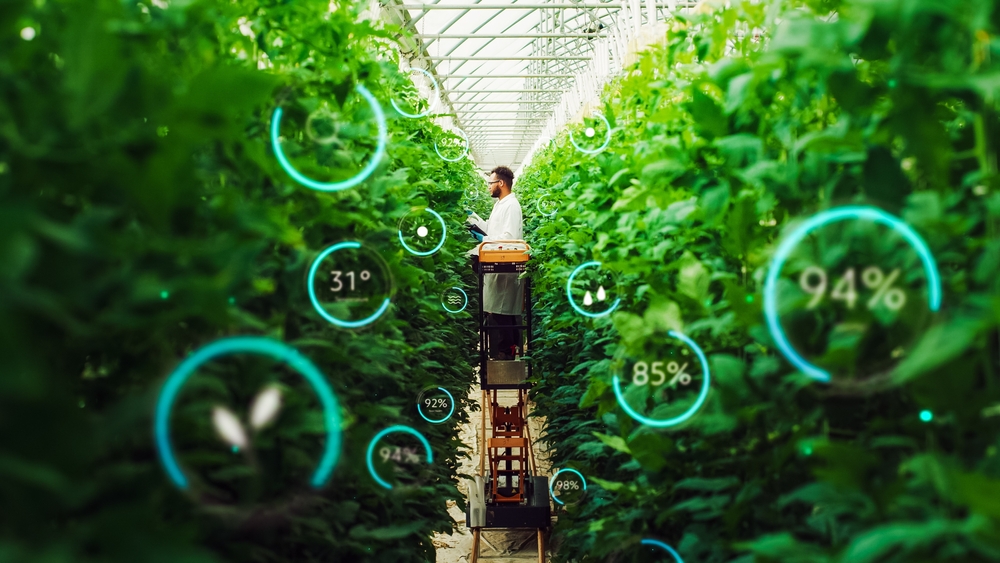AI – A Powerful Assistant in Solving Environmental Problems
1. Improve Energy Efficiency
AI systems will become “powerful assistants” when they are able to control and optimize energy use. For example, “smart grids” equipped with AI have the ability to monitor and manage power generation to meet user needs. This helps reduce energy costs while allowing for efficient and economical use of energy.

AI helps optimize energy usage
AI can also help optimize the amount of energy used by large commercial and industrial systems. Google is a prime example of this, as the tech giant has used AI to cut the amount of energy used to cool its data centers by 40%.
2. Improving Urban Infrastructure Innovation
Applying AI to waste management systems can help increase recycling rates. In the UK, recycling company Recycleye uses AI to identify materials that need to be sorted, reducing contamination and increasing the volume of recycling – thereby reducing pressure on landfills.

AI improves urban infrastructure
The AI-powered “smart city” model reduces congestion and makes public transportation systems run more smoothly. This will also reduce vehicle emissions. With the ability to collect and process large amounts of information and data, AI can help analyze weather and air pollution data from satellite sensors. AI will identify pollution sources, forecast air quality, and issue health warnings.
3. Sustainable Agricultural Development
The agricultural sector is also witnessing a meteoric rise in AI, with smart machines, robots, and AI-powered sensors making their way into every corner. They can help monitor weather, soil conditions, and crop needs in real time, helping to optimize water use and ensure that crop nutrient needs are met.

AI for sustainable agriculture
The technology can also identify pests, reducing the need for chemical pesticides on crops, thereby saving production costs and providing healthier, more nutritious food sources. As climate change worsens, AI is expected to help farmers avoid “crop failure and famine” and develop more sustainable agriculture.
4. Building Sustainable Agriculture
Agriculture is undergoing a revolution thanks to the explosion of artificial intelligence. AI technology is present in everything from smart machines, robots to sophisticated sensors, bringing significant benefits. These tools not only monitor weather, soil conditions and crop nutritional needs in real time, but also help optimize water use, ensuring healthy crops.

AI also plays a vital role in detecting pests quickly and accurately, reducing the reliance on chemical pesticides. The result is reduced production costs, while providing higher quality and more nutritious food. As climate change becomes more serious, AI offers great hope to farmers in fighting crop failure and famine, opening up the prospect of a more sustainable and prosperous agriculture in the future.
5. Sophisticated Environmental Monitoring
Climate change is becoming increasingly severe, making disaster warning a major challenge. However, with the continued advancement of artificial intelligence, we are entering a new era in predicting and responding to natural phenomena. Artificial intelligence is now capable of monitoring environmental changes with impressive accuracy and speed, providing early warnings of floods, wildfires, hurricanes, and earthquakes. This allows us to prepare in time and minimize the devastating effects of natural disasters.

AI’s ability to measure environmental indicators is also spectacular. For example, AI can track changes in icebergs 10,000 times faster than humans. Furthermore, the environmental organization The Nature Conservancy has used AI to mitigate the impact of hydroelectric projects across the Amazon region, protecting one of the most precious ecosystems on the planet.
AI – Concerns about “draining” Natural Resources
1. Huge Energy Consumption
When AI is asked to solve a problem, it consumes a large amount of energy to process it. According to one estimate, advanced AI models like ChatGPT are said to use ten times more energy than a typical Google search.

Computer models consume huge amounts of energy
Of this, only a small portion of energy demand is met by renewable energy sources. The International Energy Agency (IEA) predicts that electricity consumption from data centers, AI, and the cryptocurrency sector could double in the next four years, from 460 terawatt-hours in 2022 to more than 1,000 terawatt-hours in 2026. Meanwhile, the total electricity output consumed by people across Australia in 2022 is only about 273 terawatt-hours. That shows the amount of electricity consumed by AI is a huge number.
According to the International Energy Agency, there are more than 8,000 data centers in the world. Data center energy consumption is expected to double by 2026 compared to 2022.
Explaining the high energy consumption of AI, experts say that the initial computer models must be “trained”, that is, provided with a large data set. This process can be relatively fast but sometimes it can take up to several months. During this entire process, large data processors operate continuously 24/7.
2. High Water Consumption
AI’s water needs aren’t just energy-intensive, either. That’s because data centers that house powerful AI servers generate a lot of heat, and water is used to cool them to keep them at safe operating temperatures. In fact, Microsoft may have consumed a staggering 700,000 liters of clean water just to train its GPT-3 model. That’s enough water to produce 370 BMWs or 320 Teslas, according to the model.

AI consumes huge amounts of water
In a study titled “Making AI less Thirsty” by a group of scientists from the University of Colorado Riverside and the University of Texas Arlington in the US, published on the scientific website arXiv. The study estimates that 500 ml of clean water will be consumed by the data center, for each conversation consisting of 20 to 50 communication questions between ChatGPT and the user.
Chat GPT is not the only name, the list of “water drainers” also includes Google. According to Mr. Sebastian Lehuede at the Department of Ethics, AI and Society at King’s College London: “People were shocked to discover that Google’s data center will consume 168 liters of water per second right in a place facing drought.” That is also the reason why the license to operate Google’s data center in Santiago, Chile has been suspended until Google adjusts its plan to cool the servers. Another Google data center plan in Uruguay is also facing strong opposition because it consumes too much water.
The Problem of Effective AI application and controlling the Impact of AI on the environment
The rapid development of AI has opened a new era – where the Earth will be “saved” by smart and advanced technologies. But reality is proving that AI itself is becoming a threat to the environment with its ability to consume huge amounts of energy. It is time for humans to consider controlling the impact of AI on the environment.
In the European Union, an AI Act has been introduced with strict requirements for “high-risk AI systems”. Accordingly, these systems must be designed with the ability to record and measure energy consumption and its impact on the environment throughout the system’s lifecycle.

Not only governments, technology companies also need to demonstrate their responsibility in controlling the impact of AI on the environment. These technology “empires” also need to have long-term solutions to environmental problems. For example, technology giant Microsoft has set an ambitious goal of being carbon-negative by 2030. To realize this goal, Microsoft has purchased 95,000 tons of carbon capture credits, using biochar from forest waste, buried deep underground to capture carbon. This is an action worth learning, but compared to what AI is consuming environmental resources, it is still an extremely small number. To protect the environment, the world needs more actions like this.
Conclusion:
The role of AI in environmental protection is undeniable. However, its negative impacts are also a “double-edged sword” that many people are wary of. Effective application of AI but also intelligent control of AI’s impact is the goal to aim for so that AI can truly demonstrate its ability to solve environmental problems.
Comment Policy: We truly value your comments and appreciate the time you take to share your thoughts and feedback with us.
Note: Comments that are identified as spam or purely promotional will be removed.
To enhance your commenting experience, consider creating a Gravatar account. By adding an avatar and using the same e-mail here, your comments will feature a unique and recognizable avatar, making it easier for other members to identify you.
Please use a valid e-mail address so you can receive notifications when your comments receive replies.
